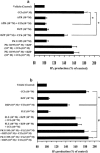Inhibitory effect of diazepam on muscarinic receptor-stimulated inositol 1,4,5-trisphosphate production in rat parotid acinar cells
- PMID: 12429566
- PMCID: PMC1573587
- DOI: 10.1038/sj.bjp.0704968
Inhibitory effect of diazepam on muscarinic receptor-stimulated inositol 1,4,5-trisphosphate production in rat parotid acinar cells
Abstract
1. This study examined the effect of diazepam (DZP) on phosphoinositide turnover, which plays an important role in the regulation of salivary secretion, in rat parotid acinar cells. 2. DZP (10(-9) M to 10(-5) M), a potent agonist of both central- and peripheral-type benzodiazepine receptors, dose-dependently decreased inositol 1,4,5-trisphosphate IP3 production stimulated by carbachol, a muscarinic receptor agonist, in the cells. 3. DZP produced a maximum inhibitory response at a concentration of 10(-5) M, with IP3 production decreased to 63% of maximal levels. The concentration inducing half maximal inhibition of IP3 production was approximately 3.5 x 10 (-8) M. 4. An inhibitory response to DZP was produced by a short-term pretreatment (<3 min) of the cells and prevented by antagonist and competing ligand for the central- and peripheral-type benzodiazepine receptors, flumazenil and PK 11195, respectively. 5. DZP showed a non-competitive inhibition of carbachol-stimulated IP3 production. It did not directly inhibit the activities of GTP-binding regulatory proteins and phosphatidylinositol 4,5-bisphosphate-specific phospholipase C (PLC) in the parotid gland membranes, though choline chloride inhibited PLC activity. 6. DZP (10(-5) M) attenuated the increase in the intracellular Ca2+ concentration ([Ca(2+)](i)) in the cells following stimulation of the muscarinic and alpha(1)-adrenoceptors. 7. These results suggest that in the parotid acinar cells, DZP inhibits muscarinic receptor-stimulated IP3 production through benzodiazepine receptors and that PLC activity which produces IP3 is inhibited by chloride. The decreases in IP3 and [Ca(2+)](i) in the cells may be connected with the suppression of salivary secretion induced by DZP.
Figures





Similar articles
-
Inhibitory regulation of amylase release in rat parotid acinar cells by benzodiazepine receptors.Eur J Pharmacol. 1998 Oct 23;359(2-3):243-9. doi: 10.1016/s0014-2999(98)00628-1. Eur J Pharmacol. 1998. PMID: 9832396
-
Relationship between muscarinic receptor occupancy and response in rat parotid acinar cells.Am J Physiol. 1993 Dec;265(6 Pt 1):G1122-7. doi: 10.1152/ajpgi.1993.265.6.G1122. Am J Physiol. 1993. PMID: 8279563
-
Beta-adrenergic receptor stimulation induces inositol trisphosphate production and Ca2+ mobilization in rat parotid acinar cells.J Biol Chem. 1988 Sep 5;263(25):12454-60. J Biol Chem. 1988. PMID: 2900837
-
[Regulation mechanisms of receptors mediated activation of phospholipase c and inositol-1,4,5-triphosphate sensitive Ca2+ release and Ca2+ uptake in exocrine glandular cells].Arzneimittelforschung. 1989 Jan;39(1A):168-73. Arzneimittelforschung. 1989. PMID: 2655616 Review. German.
-
Inositol lipids and cell stimulation in mammalian salivary gland.Cell Calcium. 1982 Oct;3(4-5):369-83. doi: 10.1016/0143-4160(82)90024-0. Cell Calcium. 1982. PMID: 6297740 Review.
Cited by
-
Effect of propofol on salivary secretion from the submandibular, sublingual, and labial glands during intravenous sedation.J Dent Anesth Pain Med. 2023 Jun;23(3):153-162. doi: 10.17245/jdapm.2023.23.3.153. Epub 2023 May 26. J Dent Anesth Pain Med. 2023. PMID: 37313266 Free PMC article.
-
Effects of Benzodiazepines on Acinar and Myoepithelial Cells.Front Pharmacol. 2016 Jun 24;7:173. doi: 10.3389/fphar.2016.00173. eCollection 2016. Front Pharmacol. 2016. PMID: 27445812 Free PMC article.
References
-
- AMBUDKAR I.S. Regulation of calcium in salivary gland secretion. Crit. Rev. Oral Biol. Med. 2000;11:4–25. - PubMed
-
- AMBUDKAR I.S., MELVIN J.E., BAUM B.J. α1-Adrenergic regulation of Cl− and Ca2+ movements in rat parotid acinar cells. Pflugers Arch. 1988;412:75–79. - PubMed
-
- AMBUDKAR I.S., HORN V.J., DAI Y., BAUM B.J. Evidence against a role for a pertussis toxin-sensitive G protein in Ca2+ mobilization in rat parotid acinar cells. Biochim. Biophys. Acta. 1990;1055:259–264. - PubMed
-
- ANHOLT R.R.H., PEDERSEN P.L., DE SOUZA E.B., SNYDER S.H. The peripheral-type benzodiazepine receptor: localization to the mitochondrial outer membrane. J. Biol. Chem. 1986;261:576–583. - PubMed
-
- BAUM B.J. Neurotransmitter control of secretion. J. Dent. Res. 1987;66:628–632. - PubMed
Publication types
MeSH terms
Substances
LinkOut - more resources
Full Text Sources
Miscellaneous

